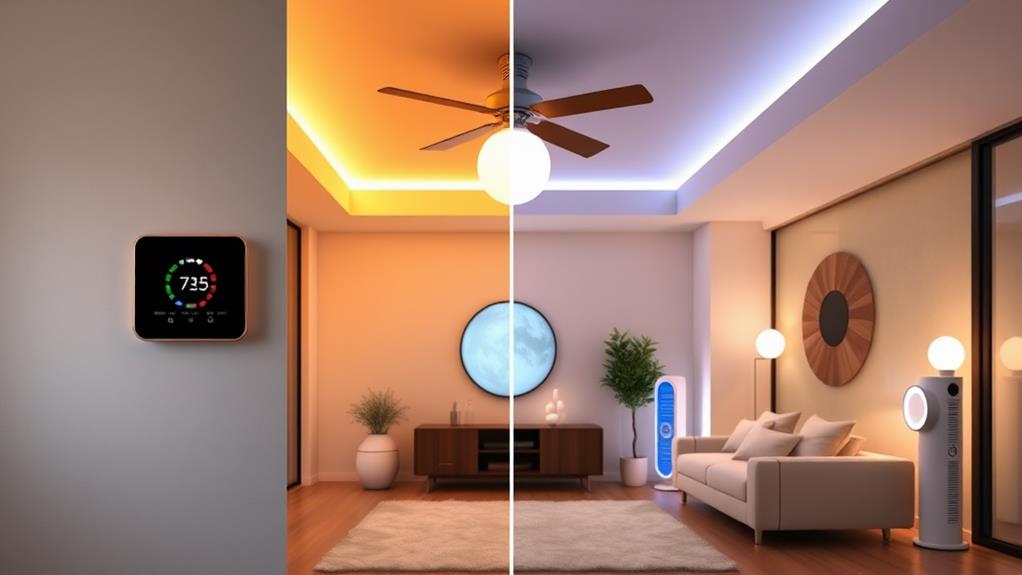LED lighting is transforming HVAC systems, offering significant energy savings and improved comfort. You'll benefit from lower power consumption, reduced heat generation, and seamless integration with smart HVAC controls. LEDs last up to 50,000 hours, saving you money on energy bills and replacements. When choosing LEDs, consider color temperature: warm whites for living areas, cool whites for workspaces. Look for ENERGY STAR certified bulbs to ensure quality and efficiency. Smart dimming options allow you to adjust lighting based on occupancy and natural light levels. By understanding LED technology, you'll unlock a world of energy-efficient, mood-enhancing lighting possibilities for your home.
The LED Revolution in HVAC
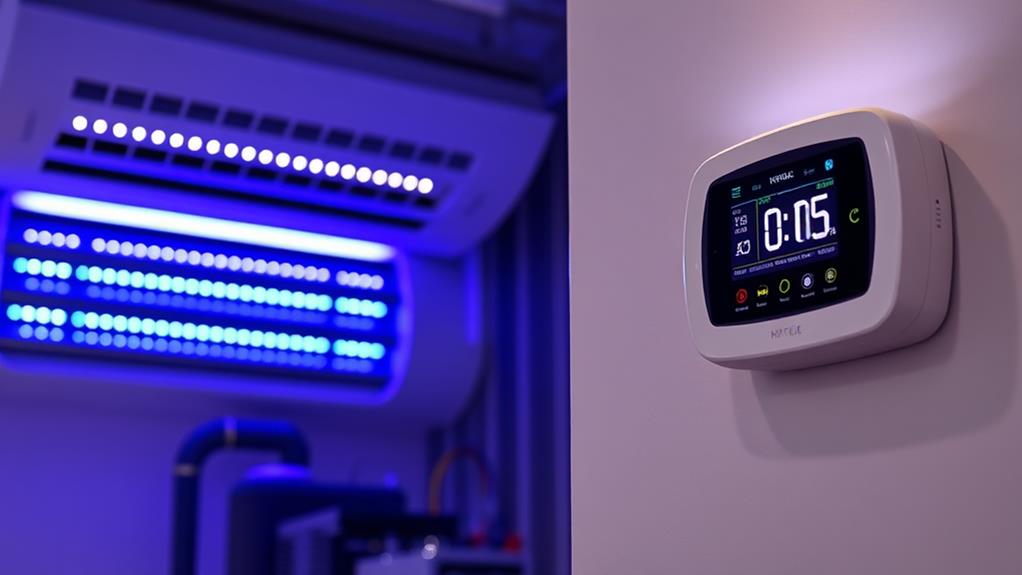
In the realm of HVAC technology, LED lighting is revolutionizing energy efficiency and control. You'll find that LED lights are rapidly replacing traditional bulbs in HVAC systems, offering numerous benefits. These energy-efficient lights consume significantly less power, reducing your overall energy costs. They also generate less heat, which means your air conditioning system won't have to work as hard to cool your space.
LED lights integrate seamlessly with smart HVAC systems, allowing you to adjust lighting based on occupancy, time of day, or specific needs. This level of control can further optimize your energy usage and create more comfortable environments. You'll appreciate the longevity of LED bulbs, which can last up to 25 times longer than traditional incandescent bulbs, reducing maintenance costs and frequency of replacements.
In HVAC applications, LED lights are particularly useful in hard-to-reach areas like air ducts or high ceilings. Their durability and resistance to vibration make them ideal for these challenging environments. As LED technology continues to advance, you can expect even more efficient and versatile lighting solutions for your HVAC systems, contributing to overall energy savings and improved system performance.
Energy Efficiency of LED Lighting
The energy efficiency of LED lighting stands at the forefront of HVAC technology advancements. You'll find that LEDs consume significantly less energy than traditional incandescent or fluorescent bulbs, making them an ideal choice for reducing your home's energy consumption. LED bulbs convert about 95% of their energy into light, wasting only 5% as heat. This efficiency translates to lower electricity bills and a reduced carbon footprint.
LED bulbs are expected to last much longer than their counterparts, often up to 25,000 hours or more. This longevity means you'll replace them less frequently, saving both money and resources. LEDs also offer instant full brightness without warm-up time, making them perfect for areas where you need immediate illumination.
When choosing LED bulbs for your HVAC system, consider factors like color temperature, brightness, and compatibility with existing fixtures. Look for ENERGY STAR certified products to ensure you're getting high-quality, energy-efficient options. By integrating LED lighting into your HVAC setup, you'll not only improve energy efficiency but also enhance the overall comfort and functionality of your home's climate control system.
Integrating LEDS With Smart HVAC
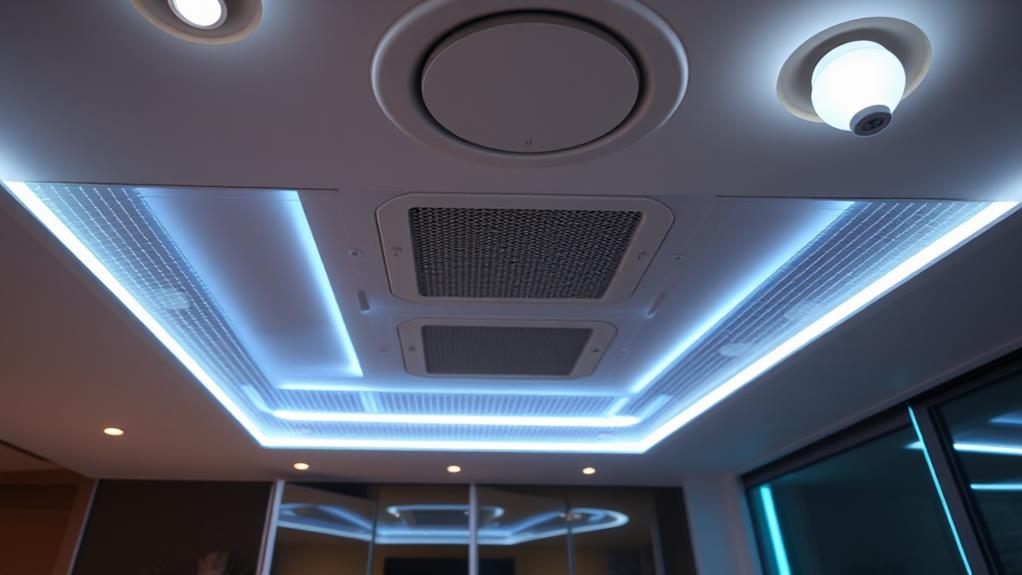
Integrating LEDs with smart HVAC systems creates a powerful synergy that can dramatically enhance your home's energy efficiency and comfort. By connecting your LED lighting to your smart thermostat and HVAC controls, you'll unlock advanced automation possibilities. For example, your system can adjust lighting brightness and color temperature in tandem with heating and cooling cycles, optimizing both visual comfort and energy usage.
Smart sensors can detect occupancy and natural light levels, allowing your integrated system to automatically dim or brighten LEDs while adjusting HVAC settings. This coordinated approach ensures you're not wasting energy on empty rooms or overlit spaces. You can also program lighting scenes that work in harmony with your HVAC preferences, such as a "sleep" mode that gradually dims lights while lowering the temperature.
The integration enables more sophisticated energy management. Your smart home hub can analyze data from both systems, providing insights into usage patterns and suggesting optimizations. You'll receive alerts about potential issues, like unusual energy spikes, and can control everything remotely via smartphone. By leveraging the combined efficiency of LEDs and smart HVAC, you'll significantly reduce your home's overall energy consumption and enjoy a more responsive, comfortable living environment.
LED Lifespan and Cost Savings
LED bulbs consistently outshine traditional lighting options when it comes to lifespan and cost savings. You'll find that LEDs typically last 25,000 to 50,000 hours, significantly outlasting incandescent bulbs (1,000 hours) and CFLs (8,000 to 10,000 hours). This extended lifespan means you'll replace your LED bulbs far less frequently, saving time and money on replacements.
While the initial cost of LED bulbs is higher, you'll recoup this investment through energy savings. LEDs use about 75% less energy than incandescent bulbs, directly translating to lower electricity bills. Over the bulb's lifetime, you can expect to save $30 to $80 per bulb in energy costs.
LEDs also offer indirect cost savings. Their cooler operation reduces the load on your air conditioning system, further decreasing energy consumption. Additionally, their durability means less waste and fewer replacements, reducing your environmental impact.
To maximize these benefits, choose LEDs with the ENERGY STAR label, which guarantees quality and efficiency. Also, consider the color temperature and lumens to ensure you're getting the right brightness and ambiance for each room in your home.
Color Temperature and Mood Control
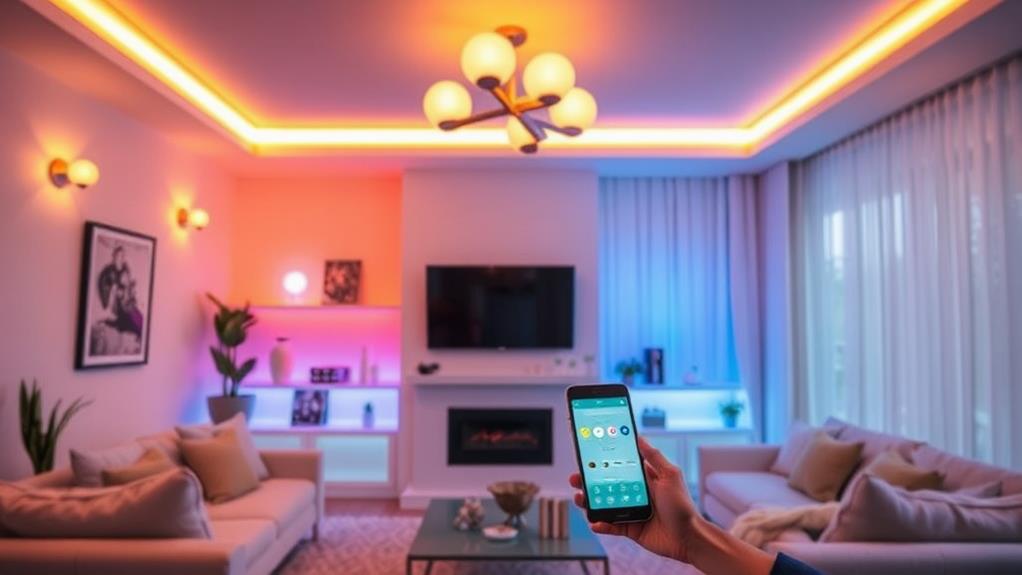
With LED lighting technology, you're not just controlling brightness; you're also influencing mood through color temperature. Color temperature, measured in Kelvin (K), ranges from warm (2700K-3000K) to cool (5000K-6500K) tones. Warmer temperatures create a cozy, relaxing atmosphere, ideal for living rooms and bedrooms.
Cooler temperatures promote alertness and are better suited for workspaces and kitchens.
You can now adjust your home's lighting to match your activities and circadian rhythm. In the morning, use cooler temperatures to help you wake up and feel energized. As evening approaches, switch to warmer tones to promote relaxation and prepare for sleep. Many LED systems offer programmable options, allowing you to automate these changes throughout the day.
Some advanced LED systems even provide full-spectrum color control, enabling you to create custom ambiances for different occasions. Whether you're hosting a dinner party or watching a movie, you can set the perfect mood with a few taps on your smartphone. By understanding and utilizing color temperature, you'll enhance your living space's functionality and comfort while potentially improving your overall well-being.
Choosing LEDs for Different Rooms
Now that you understand how color temperature affects mood, let's apply this knowledge to specific rooms in your home. For living rooms and bedrooms, opt for warm white LEDs with a color temperature between 2700K and 3000K. These create a cozy, relaxing atmosphere perfect for unwinding after a long day.
In your home office or study area, choose cool white LEDs (4000K to 5000K) to promote alertness and productivity.
Kitchens benefit from neutral white LEDs (3500K to 4000K), which provide clear, crisp light for food preparation and cooking. In bathrooms, install LEDs with a color temperature around 3000K to 4000K for a balance between warmth and clarity, ideal for grooming tasks.
For outdoor lighting, consider cool white LEDs (5000K to 6500K) to enhance visibility and security.
When selecting LEDs, also consider the Color Rendering Index (CRI). Choose bulbs with a CRI of 90 or higher for the most accurate color representation, especially in areas where color perception is crucial, such as closets or art studios. Don't forget to check the lumen output to ensure adequate brightness for each space.
LED Dimming and Control Options

Dimming capabilities and smart controls have revolutionized LED lighting, offering unprecedented flexibility and energy savings. You'll find a range of options to suit your needs, from simple dimmer switches to sophisticated smart home systems.
Basic dimmer switches allow you to adjust light levels manually, creating the perfect ambiance for any occasion. However, for more advanced control, consider investing in smart LED bulbs or fixtures. These can be controlled via smartphone apps or voice assistants, letting you adjust brightness, color temperature, and even colors with ease.
Some smart LED systems offer scheduling features, allowing you to automate your lighting based on time of day or occupancy. This can significantly reduce energy consumption and extend bulb life. You can also integrate LED lighting with other smart home devices for seamless automation.
For outdoor lighting, motion sensors and daylight sensors can provide additional energy savings and security. These controls ensure lights are only on when needed, reducing unnecessary usage.
When selecting LED dimming and control options, consider compatibility with your existing fixtures and wiring. Some older dimmer switches may not work well with LEDs, so you might need to upgrade your switches for optimal performance.
Environmental Impact of LED Adoption
The widespread adoption of LED lighting has ushered in a new era of energy efficiency and environmental responsibility. When you switch to LEDs, you're making a significant impact on reducing your carbon footprint. LED bulbs consume up to 90% less energy than traditional incandescent bulbs, which translates to lower electricity demand and reduced greenhouse gas emissions from power plants.
LEDs last 25 times longer than incandescent bulbs, meaning fewer replacements and less waste in landfills. They don't contain hazardous materials like mercury, making disposal safer and easier. By choosing LEDs, you're helping to conserve natural resources used in manufacturing and transportation.
LED production has become more environmentally friendly, with manufacturers focusing on sustainable practices and materials. As you invest in LED technology, you're supporting this green industry growth. The reduced energy consumption of LEDs also means less strain on power grids, potentially decreasing the need for new power plants. Your decision to use LEDs contributes to a cleaner environment, energy independence, and a more sustainable future for generations to come.
Future Innovations in LED Technology
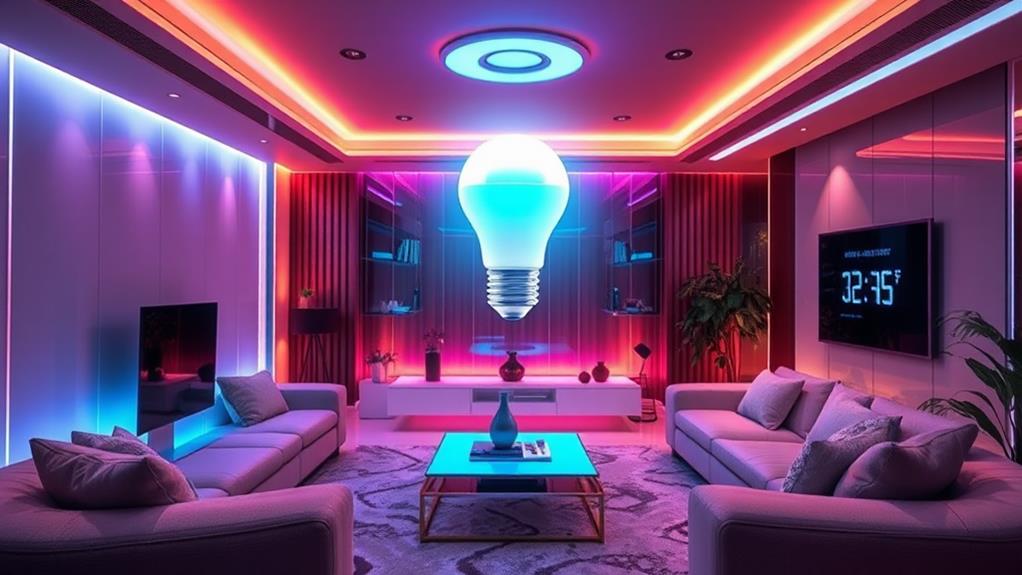
Innovations in LED technology continue to push the boundaries of lighting efficiency and versatility. You'll soon see LEDs with even higher lumens per watt, further reducing energy consumption. Researchers are developing quantum dot LEDs, which will offer superior color rendering and efficiency. These next-gen LEDs will provide more accurate and vibrant colors, enhancing your home's ambiance.
Flexible and printable LEDs are on the horizon, allowing for creative lighting designs and integration into various surfaces. You'll be able to illuminate your walls, ceilings, or furniture seamlessly. Smart LEDs with built-in sensors and wireless connectivity will become more sophisticated, responding to your presence, adjusting to natural light, and integrating with your home automation systems.
Li-Fi technology, using LEDs for data transmission, will revolutionize how you connect to the internet. Your light fixtures could double as high-speed wireless access points. Organic LEDs (OLEDs) will become more affordable and widespread, offering ultra-thin, flexible panels for unique lighting solutions. You'll also see advancements in human-centric lighting, with LEDs that can adjust their color temperature throughout the day to support your circadian rhythm and overall well-being.
Conclusion
As you embrace LED lighting in your home, you're joining a global shift towards energy efficiency. Did you know that LED bulbs use up to 75% less energy than incandescent bulbs? By making the switch, you'll not only reduce your carbon footprint but also save significantly on energy bills. With smart integration, mood-enhancing capabilities, and ongoing innovations, LEDs are transforming how we light and control our living spaces. It's time to illuminate your future with LEDs.
